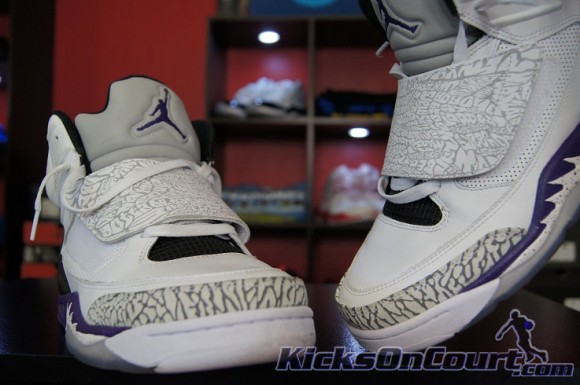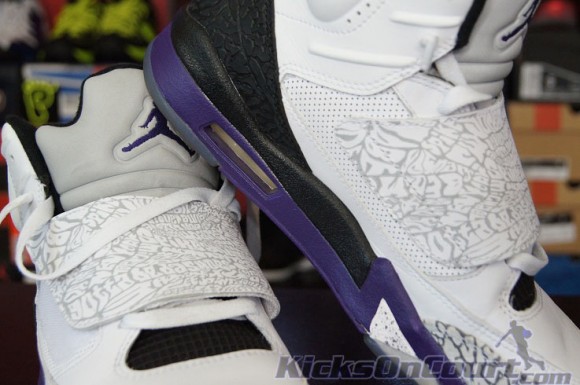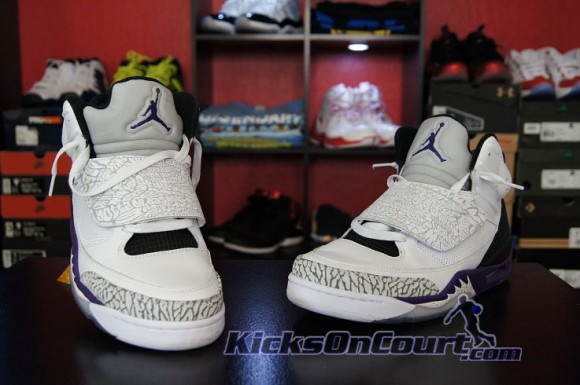Hit the jump for full review and scores…
Traction – A few sections on this shoe will be repetitive due to their construction – utilizing the same midsole and outsole tooling as the AJV – so I will try to keep it short. Traction was perfectly fine IF you keep the outsole debris free. If you don’t have a traction mat handy all you have to do is simply wipe the outsole regularly – each dead ball – or you can bring a lint roller or some duct tape with you to help remove debris.
Front to back the surface is great, even curling around screens, cutting and hard crossovers can be performed with ease. Only issues I came across are the same ones I had with the AJV at the smooth surfaced heel – just the trim – as it gave some minor slipping which can cause some hesitation. You can try to avoid this by adjusting your foot strikes… its very plausible to adjust to what a particular sneaker offers you so long as you are aware of your own bodies movement and style.
Cushion – Heel and forefoot Air units are in place along with the Polyurethane midsole. A bit stiff at first but given enough time they will eventually break-in and feel pretty nice when directly comparing it to the Polyurethane used in the AJ3-4 & 6. A simple insole swap can also remedy any lack of cushion you feel you are receiving so there is always a way to modify certain aspects of a shoes performance if you are willing to do so.
Material & Fit – I personally loved the leather used along the upper. There are nubuck versions as well but I feel that leather is able to retain its shape a bit better overtime and maintains the overall look if you choose to rock your sneakers on and off the court. Additionally, the leather is super soft and plush… something I wish was used more on Retro models, so break-in time is very minimal.
The upper is comprised of the Air Jordan 3, 4, 6 & 20. I feel they used to best parts of each shoe which serves a dual purpose… mostly aesthetics, however, there are performance features hidden within these models even though most will only see these as a casual shoe. Below is a small breakdown on what each signature models design features will bring to the table as far as performance is concerned…
AJ3 – Elephant print looks great but it’s also in place to protect the layers of material underneath. When soft leather is used you will wear through the material quickly and that is why the elephant print is place and the toe and heel… both are high wear areas.
AJ4 – Ventilation… that’s why the mesh and netting are in place. It’s not as functional as Fuse or SPRINTWEB but it offers some air flow and a point where moisture and heat can escape.
AJ6 – The high ankle cut keeps the foot locked into place if laced all the way to the top. If you happen to wear a brace leaving the lacing down one eyelet won’t harm anything and itll allow you to have some range of motion while your brace does the rest of the work restricting certain movements.
AJ20 – The midfoot strap keeps the foot in place. If used properly and with slight modifications by adding a thicker insole or a thinner insole on top of the one provided you will receive greater lockdown in this area.
The breakdown above notes that an additional or thicker insole is recommended. This will raise the foot up a bit higher to cancel out the dead space within the toe. Had I realized this when playing in the Air Jordan V Retro I would have had a better experience overall but I did figure it out while playing in the AJ6 so not all is lost. Some feel as if I am an expert in this field which is flattering but false as I learn something new every day. Keep an open mind and don’t be afraid to try new things and you will pick up a few things along the way that will help you maximize your on-court performance with nearly any piece of footwear you happen to choose playing in.
Ventilation – Perforations are in place along the side panels, heel and tongue. Most of your air flow will come from the tongue itself as this is the area that allows to most heat & moisture to escape. It’s not perfect since the strap will retain that moisture as it builds up a bit but it’s better than nothing.
Support – Not much ‘support’ is provided – something I’m used to in these older styled models – but what is in place can and will work. The molded arch in the midsole offers some support for your arch so you don’t over flex the area and strain your foot. The strap and fit itself will take care of the rest so long as you remove the dead space issue from the equation. If you happen to have a wide forefoot this won’t be too much of an issue but if you are like me and have a narrow foot then you will want to either replace the insole with one that offers you more lift within the shoe or place a thinner insole on top of what is already in place.
Overall – These started out rough but I was able to work through all of the kinks and make them playable. Not only are they more than capable on-court but they performed very well after the additional insole was in place. I actually had some very good games while playing in the Son of Mars so that was a big bonus as well… playing well in a certain shoe ends up making you favor that particular model with fond memories… hence having nostalgia come into play while wearing a Retro on-court.
If you were looking for something with Retro styling but wish to keep your Retro models in good shape, the Jordan Son of Mars can be a good alternative… even if the people you play with shake their head in disbelief.
[wp_ad_camp_1]











i like your sneaker room, looks really dope. are you gonna review these? http://www.underarmour.com/shop/us/en/pid1220966-602
Thanks. Prob not anymore since they are so old.
nice review. i might end up checking them out if they hit the outlets. hehe.
Kind of unrelated but since we’re talking about retros. What ever happened to the huarache free 2012? Were they that bad on court that you couldn’t finish a review?